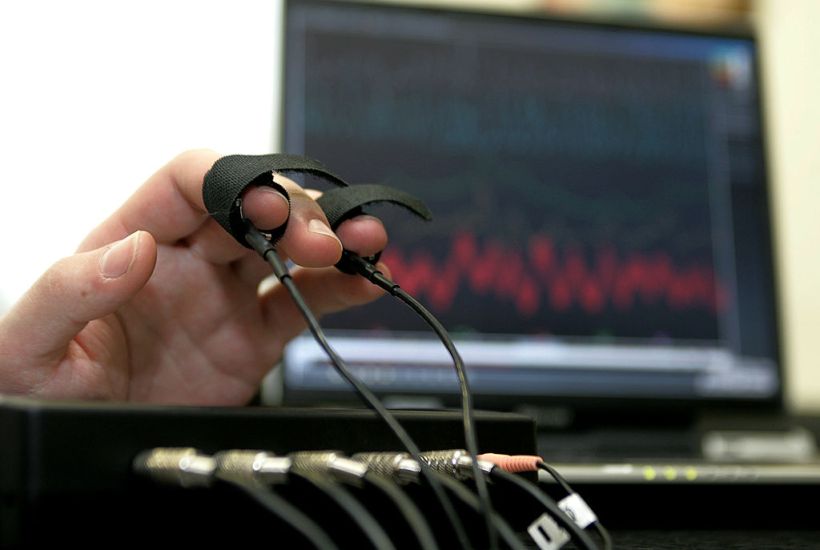You might have assumed that the polygraph (or ‘lie detector’ as it is commonly known) was something used only for entertainment on the Jeremy Kyle Show. It is, after all, little more than a relic from the 1920s when people turned to psychic mediums and truth-telling machines in the misguided search for certainty after the horrors of the Great War. So it might come as a surprise that the polygraph has been used by the penal system in England and Wales for more than a decade. The Probation Service, in fact, uses them to monitor sex offenders released on licence. In the past five years alone, 5,228 mandatory polygraph examinations have been carried out on 2,249 sexual offenders, according to the Home Office.
Few people are likely to be concerned about their use on sex offenders; anything that could prevent re-offending is probably assumed to be a good thing. However, there is a new development when it comes to polygraphs that should worry everyone who cares about due process. The Domestic Abuse Bill and the Counter-Terrorism and Sentencing Bill, both in final stages of the parliamentary process, include proposals to use polygraphs to monitor certain domestic violence and terrorism offenders, and individuals who are subject to Terrorism Prevention and Investigation Measures.
Again, you might shrug your shoulders. Does it matter if the polygraph is only used to monitor such unsavoury individuals? Yes, it does. For this development will see our criminal justice system invaded by the widespread use of a wholly unscientific and unreliable machine.
So how do they work? Polygraphs measure physiological data such as heart and breathing rate, blood pressure and sweat. Their design has changed little since a century ago, when William Marston (designer of the polygraph’s prototype and creator of the superhero Wonder Woman) unsuccessfully attempted to persuade a US court in the famous Frye murder trial to accept evidence from his lie detector test. The inadmissibility of polygraph testimony in criminal courts in the US continues to this day.
The polygraph machine tells us nothing. There is no scientifically established link between truthfulness and physiological functions. The US National Security Council noted in 2003:
‘Although psychological states often associated with deception … do tend to affect the physiological responses that the polygraph measures, these same states can arise in the absence of deception.’
In other words, someone who is lying might have an increased heart rate or sweat more than normal; but this might happen to someone who is not lying but is nervous, stressed, or has some other condition. We cannot reliably conclude that someone is deceptive from their physiological arousal. Nor can we infer truthfulness if this doesn’t happen.
What is important is the interview and not the device. The device, in fact, is redundant, provided that the interviewee believe in the validity of the polygraph — homicide detectives in Detroit, for instance, are believed to have used their photocopier as a fake polygraph device. As polygraph operators admit, polygraphy is primarily ‘a psychological procedure and only secondarily of a physiological nature’. So, the polygraph ‘test’ is essentially an interrogation tool. But it does not detect anything meaningful.
Psychological pressure, however, tends to reduce the value of the information extracted. As criminologist Cesare Beccaria noted when discussing oppressive investigation methods, we only get information about ‘the force of the muscles and the sensibility of the nerves’ of the accused person rather than a truth-conducive statement.
Lacking reliable scientific evidence, the Home Office has to rely on figures from the American Polygraph Association — an industry trade body — to justify claims of ‘accuracy’. Even so, a ‘failed’ test can be disclosed to the police to justify action. The answers given during a test may well mean that a person becomes subject to stricter licence conditions or even recalled back to prison.
How much are polygraphs used in the police force? In England and Wales police are discouraged, but not banned, from using the tests within investigations. We sent Freedom of Information requests to 46 police forces asking how many used polygraphs: 37 forces would neither confirm nor deny their use and only five, including Police Scotland, directly denied their use. Some forces stated that they do not use polygraphs in an ‘overt’ capacity, without clarifying what this means.
Therefore it cannot be ruled out that the polygraph is being used in investigatory work. We know that polygraph testing of suspected sexual offenders has already been officially trialled by the police. Our research also found that polygraph tests were being used as a bail condition in relation to community sentences, for which there is no statutory basis. It seems the polygraph is slowly seeping into all aspects of our justice system.
We rightly expect and require the police and the state only to take intrusive and coercive action when there are reasonable grounds for doing so. How can the output of the polygraph, which is inadmissible in criminal courts in England and Wales, qualify as ‘reasonable grounds’? Some might argue that probation is different and, therefore, standards can be lower. But probation is an integral part of the penal system, and should be subject to the same basic standards required by the rule of law, respect for rights and procedural safeguards.
There is also the issue of false negatives: people can lie and appear on the polygraph to tell the truth. Indeed, if a polygraph finds ‘no deception indicated’, then it could allow controls on the offender to be reduced.
In written evidence to parliament, we argued that the Counter-Terrorism and Sentencing Bill suggests that the polygraph’s assessment of truthfulness or deceptiveness of the individual could be used to determine whether Terrorist Prevention and Investigation measures are continued, expanded or discontinued. Public officials who have to take difficult decisions about who might pose a terrorist threat may welcome a machine that appears to give them a sense of certainty, and that is understandable. But it is a false sense of security.
Finally, the absence of independent oversight and regulation, both in respect of scientific validity and the deployment of the polygraph, gives cause for concern. We have a situation where the American Polygraph Association, a body with an inherent interest in promoting the agenda of its own members, applies its ‘standards’ and training as part of the polygraph regime. It’s the equivalent of putting CCTV camera manufacturers in charge of overseeing the use of facial recognition.
Got something to add? Join the discussion and comment below.
Get 10 issues for just $10
Subscribe to The Spectator Australia today for the next 10 magazine issues, plus full online access, for just $10.
Dr Kyriakos N. Kotsoglou is senior lecturer in law at Northumbria University. Dr Marion Oswald is vice-chancellor’s senior fellow in law at Northumbria University and associate fellow of the Royal United Services Institute




















Comments
Don't miss out
Join the conversation with other Spectator Australia readers. Subscribe to leave a comment.
SUBSCRIBEAlready a subscriber? Log in